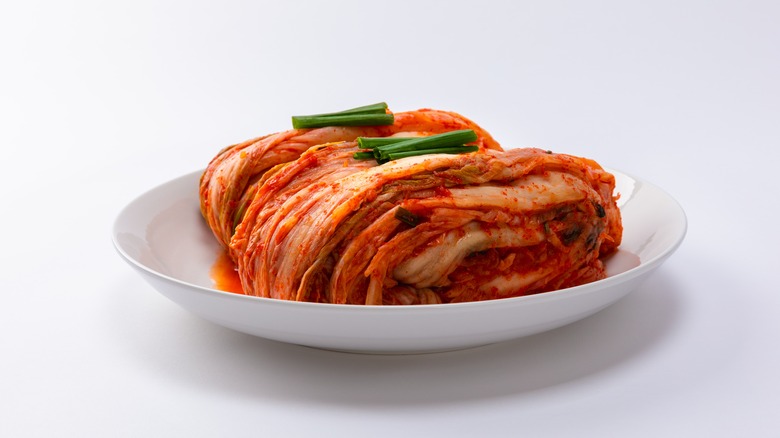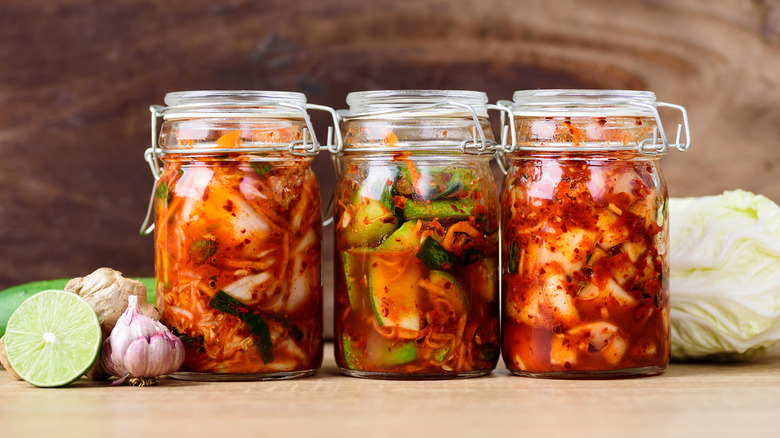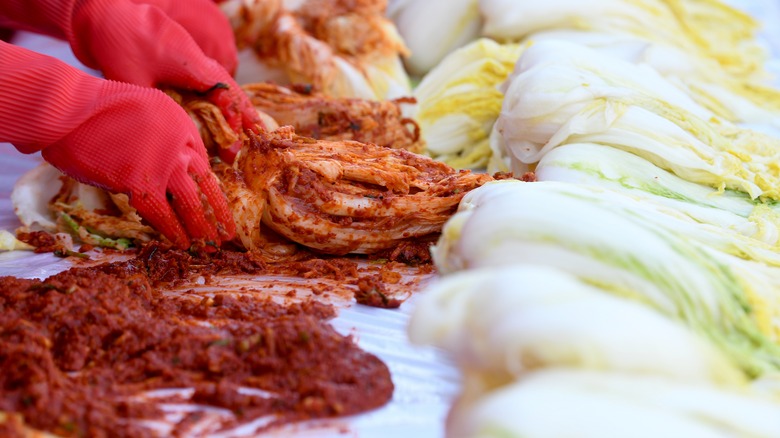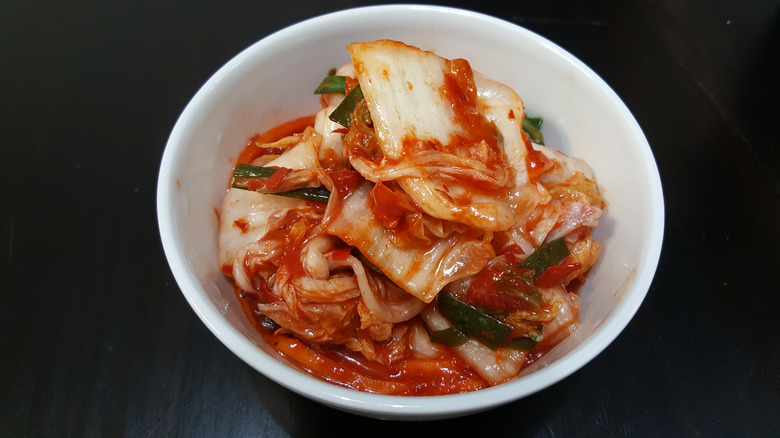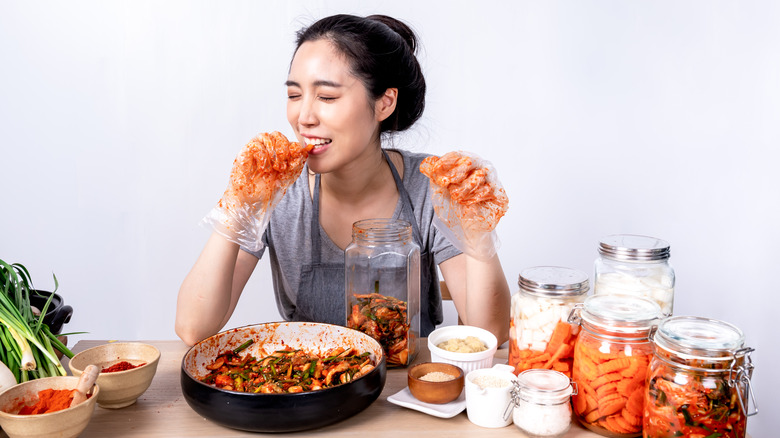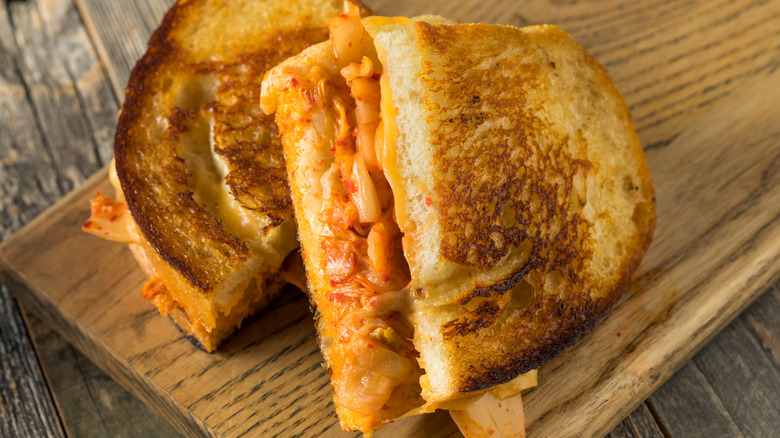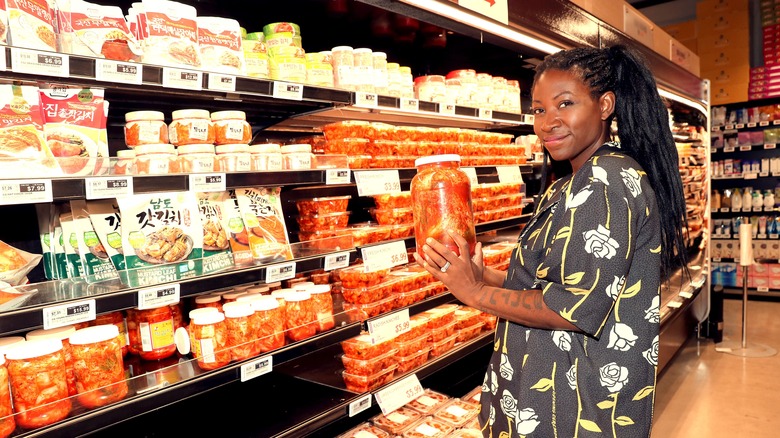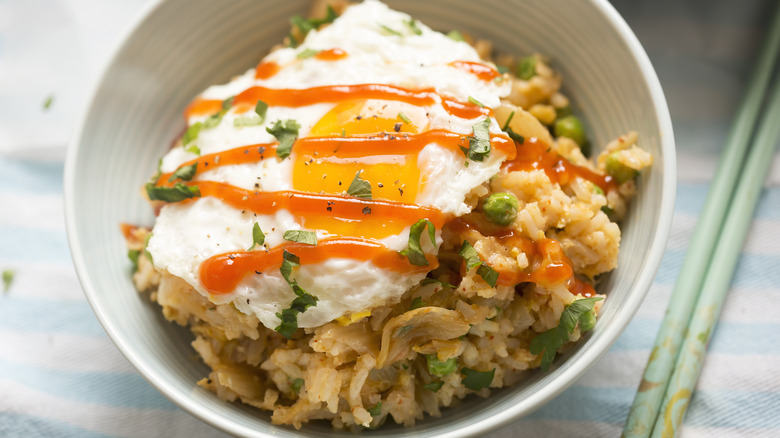What Is Kimchi? A Quick Guide To The Powerhouse Staple Ingredient
Kimchi is a delicious fermented cabbage dish that is essential in any banchan, which translates to side dishes in Korean. If you've had the pleasure of visiting a Korean barbecue restaurant before, you'll know that banchan are tiny plates of various sides served for free and with free refills, like seaweed salad, pickled radish, bean sprouts, and of course, kimchi.
Yet, make no mistake. Kimchi is not just a humble and unassuming side dish, it is actually an entire country's pride and joy. It is South Korea's bona fide national dish that has inspired a World Kimchi Institute. In 2015, kimchi was bestowed the title of Intangible Cultural Heritage by Unesco. Clearly, the spicy and sour dish is not just a food, it's a cultural symbol that's not only rich in history and tradition but is also a nutrient-dense powerhouse with many health benefits that have been studied by science and touted by nutritionists. Here's everything you need to know about kimchi.
What is kimchi?
While there are over hundreds of kimchi types, the base formula involves a fermented vegetable that usually has gochugaru, or Korean chili pepper powder. Other variants of kimchi include no chili, making it white and not spicy; and Cheongyang chili, which makes it much hotter than the average Korean chili pepper.
Napa cabbage (Brassica rapa) is the most popular vegetable used in kimchi, but any of the vegetables or greens used are seasoned with spices, fermented seafood, fruit, and even meat or fish before becoming transformed by a lactic-acid fermentation process. There is no single standard recipe for making kimchi, but other common ingredients include carrots, radishes, and anchovies. Kimchi can also be considered as a general term for vegetables that have undergone a specific fermentation process that dates back to as early as 75 B.C. – A.D. 668, as it was a Korean staple during the Three Kingdoms era.
How is kimchi made?
The most common type of kimchi — the spicy kind with bits of chopped-up napa cabbage brined red — is called tongbaechu-kimchi or baechu-kimchi, or pogi-kimchi in Korean. In Korea, kimchi making is a collective and socially-bonding activity called kimjang, which is done in advance of winter.
This classic kimchi uses napa cabbage, which is usually first soaked in two length-wide halves in a salt brine for a couple of hours. Then, the cabbage is quartered, rinsed, and drained. A sauce mixture is made in the interim (cooking water, sweet rice flour, and sugar), to which spices are later added, like garlic, ginger, fish sauce, fermented salt shrimp, and hot pepper flakes. The resulting concoction is a fiery red paste to which other thinly-sliced vegetables are mixed in, like radishes, carrots, chives, or green onions. It is slathered over each individual napa cabbage leaf that's then coiled tightly and left to ferment in a container, letting the lactobacillus bacteria work its magic before consumption.
Classical cabbage kimchi v. mak kimchi and other types
Pogi-kimchi, which is the classical cabbage kimchi, transforms into its final fermented state in whole halves. Mak kimchi, on the other hand, is made with cabbage leaves that are cut up, which it makes both the cooking process (no rolling needed) and the consumption (no cutting or chopping) super easy.
Beyond cabbage kimchi, there are many types of kimchi with different vegetables and names, such as green onion kimchi (pa kimchi), cucumber-based kimchi (oi sobagi), and diced radish kimchi (kkakdugi). In Chinese cuisine, there is pao cai, a similar dish from Sichuan. However, insistence on the similarities and singular origins of kimchi and pao cai is controversial, and the two are distinct foods with different recipes stemming from different cultures. Kimchi is uniquely a Korean invention and any claim that it has origins in pao cai or has Japanese influence has been thoroughly disputed.
What does kimchi taste like?
For those that are tasting kimchi for the first time, especially pogi-kimchi, be prepared for an intense flavor burst. Fermentation leads to a sour, tangy taste, and the spices from the chili are hot — though the spicy level will vary based on what recipe was used. Texture-wise, the vegetables used in kimchi lend it a natural crunch.
White kimchi, or baek-kimchi, on the other hand, is equally intense in flavor but is not spicy. Other spices like cloves, onion, and ginger, nuts such as pine nuts and chestnuts, and fruits like Asian pear and jujube add to a more complex flavor profile. Some will enjoy eating kimchi on its own, while others may like having it with rice or with other savory foods, which will add a starchy balance to the intense flavor of the fermented vegetables.
How to eat and cook with kimchi
Obviously, kimchi can be eaten raw straight from its package or as a side dish, but the popularity of this fermented vegetable has led to the liberal use of kimchi in many recipes. It can be a tangy addition to your favorite dumpling recipe, be used to bring fried rice to the spicy next level, and be used in udon noodles. Essentially, take any recipe, and you can most likely make a kimchi-flavored version.
Kimchi's taste profile pairs well with foods across cultures, too — every few years there is a grilled kimchi cheese sandwich craze. Everyone from Korean food influencer Maangchi to Gordon Ramsay to the New York Times has tested and approved the grilled cheese and kimchi trend. And if you think about it, the combination makes sense; the richness of cheese is nicely counterbalanced by the salty, tangy, sour kimchi. Even mac and cheese is good with kimchi in it!
Where to buy kimchi
If you don't have the time to make your own kimchi, it's easy to find and buy it around the United States. Kimchi is available at nationwide chains like Walmart; Whole Foods carries the artisanal kimchi brand Mother In Law's Kimchi; and for bigger fermented appetites or families, even Costco carries kimchi in large quantities. Fresh kimchi will be found in the refrigerator aisles, and at home, kimchi will keep for up to 12 months. Real diehard kimchi fans (for those who make their own) will do well to equip themselves with a special kimchi refrigerator, which espouses optimal fermentation conditions.
It goes without saying that your local H Mart will undoubtedly have a large kimchi reserve for sale, where you'll find the many varieties of kimchi available on the market. Online shoppers can also get their kimchi fix on Amazon, along with kimchi paste, kimchi-flavored almonds, ramen kimchi, and more.
The many health benefits of kimchi
Kimchi's nutritional benefits are endless. To begin with, the cabbage base itself is packed with vitamins A and C, minerals, and amino acids, according to Healthline. If there are carrots or other vegetables used, those health benefits are reaped as well.
However, the real boost comes from the probiotics found in kimchi, or the live bacteria and yeasts that the NHS explains can help restore balance to your gut health system. A study published by the Elsevier Public Health Emergency Collection found kimchi has antiviral properties and can generally boost the immune system.
Kimchi is also low in calories — there are about 23 for one cup — and also has plenty of beta-carotene and other antioxidants that help ward against cancer and other diseases. The only risk of eating kimchi is that if it goes bad, harmful bacteria may sneak in and cause food poisoning. If you're unaccustomed to eating kimchi, also take note it may cause gas or bloating, but generally, the positives of eating kimchi outweigh any negatives.
